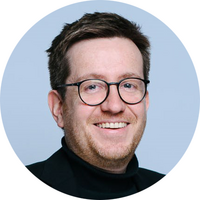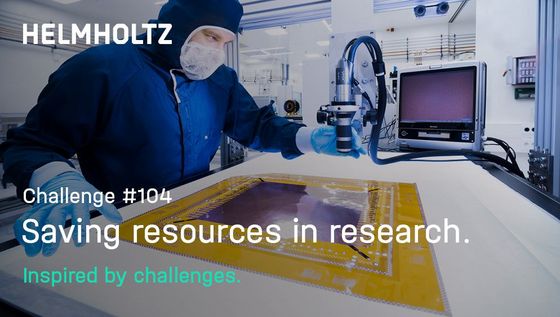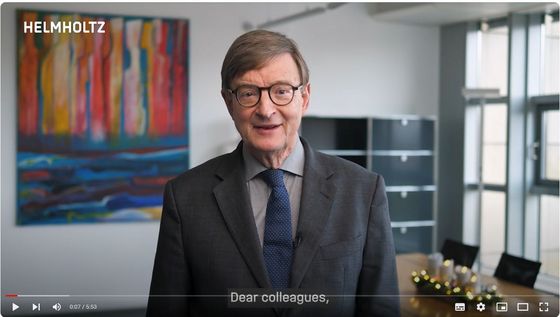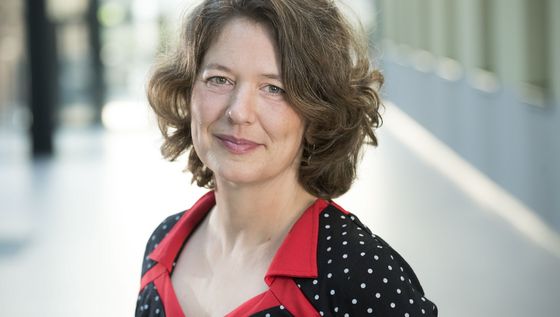|
||||||||
|
||||||||||||||||||||||||||||||||||||
|
|
A year is drawing to a close in which the world has become even more unpredictable than it already was. In this issue, Otmar Wiestler, President of the Helmholtz Association, looks back on the past few months, which have been very eventful for the entire scientific community. Talents from all over the world making meaningful contributions to society within the Helmholtz Association give us hope. Ulrika Beitnere from Max Delbrück Center is one of these talents. She has just moved from California to Berlin to work in diabetes research. We introduce her to you here. December is consumer season like no other month. However, the resulting huge amount of plastic that is released into the environment every year is harmful to the health of practically all organisms in the oceans and on land, as well as for us humans. Melanie Bergmann from the Alfred Wegener Institute speaks out in favor of an international agreement to curb plastic waste. And finally, if you‘re looking for something special for Christmas dinner, you might find it at the end of this newsletter. We wish you an enjoyable read, happy holidays and a good start to the New Year! |
|
|
|
|||||||||||||||||||||||
|
|
|
|
|||||||||||||||||||||||
|
|
|
It has become a tradition for Otmar Wiestler to send a Christmas greeting to the employees of all Helmholtz Centers at the end of the year. In times of profound changes, he emphasizes the mission of the Helmholtz Association to actively shape this upheaval. Watch video message |
|
Together with the Stifterverband für die Deutsche Wissenschaft, the Helmholtz Association presents the “Helmholtz High Impact Award - Science Prize with the Stifterverband”, endowed with 50,000 euros. The deadline for submitting proposals from the Helmholtz Centers to the Helmholtz Head Office is March 30, 2024. To the call for proposals
The Helmholtz Investigator Groups offer top international talents early scientific independence. The Helmholtz Association funds up to nine groups. Deadline for the submission of applications by the Helmholtz Centers to the Helmholtz Head Office is April 30, 2024. To the call for proposals |
|
|
|
Where there is nothing, all complexity should be reduced to zero, or so you might think. But modern physics contradicts this. “The vacuum itself is the carrier of the laws of nature and thus also a kind of ‘primordial substance’ from which the existence of all elementary particles can arise,” says Ralf Schützhold, Professor at TU Dresden and Director of the Institute for Theoretical Physics at the Helmholtz-Zentrum Dresden-Rossendorf (HZDR). In other words: The vacuum is not simply a void, but has structure. This sounds rather philosophical, but it is one of the central statements of modern physics. “In our world, the famous Heisenberg uncertainty principle applies,” explains Schützhold. “According to this, there is a certain uncertainty everywhere in nature, i.e., a limit to what can be precisely determined.” Accordingly, there is no such thing as an absolutely empty space that contains neither particles nor electromagnetic fields, it is always filled with tiny quantum fluctuations. “There are different ways of visualizing this abstract concept of quantum fluctuation,” says Schützhold. “You can call it a ‘quantum flicker’ because the quantum fields undergo fluctuations in a very small space and on extremely short time scales that cannot be explained classically.” There is also often talk of “virtual particles”, which are created in a vacuum and disappear again practically instantaneously. The exciting thing about this is that the state of the vacuum can be manipulated. If you bring two electrically conductive plates very close together, only certain quantum fluctuations can form between them, whereas other quantum fluctuations, which occur in free space, can no longer. The difference between the quantum fluctuations inside and outside the plates creates a tiny force that presses the two plates together. “This force is known as the Casimir effect after its discoverer,” says Schützhold. “We now want to demonstrate a related effect, although we are working with laser beams and not with conductive materials.” To this end, researchers from the HZDR are working with colleagues to set up a special experiment at the European XFEL near Hamburg, the world's largest and most powerful X-ray laser, which is one of the Helmholtz Association’s flagship experiments due to its pioneering technology and significance for physics. The European XFEL makes it possible to test quantum fluctuations with extremely high field strengths. The idea behind the experiment is as follows: An extremely strong, optical laser pulse is shot into a vacuum chamber and focused very sharply on a single point. Enormous electromagnetic field strengths can be achieved at this focal point, which polarize the quantum vacuum. “We want to get the quantum flicker to vibrate preferentially in one direction, so to speak,” says Schützhold. An X-ray pulse should then pass through the focal point of the optical laser beam at the same time. Such an X-ray pulse contains around one trillion X-ray photons. “In this experimental setup, approximately one of these one trillion X-ray photons should have undergone a measurable change in polarization per pulse due to the influence of the polarized vacuum, which we want to prove with the help of polarization filters,” says Schützhold. “This means we are pretty much at the limit of current measurement technology to detect this extremely weak effect.” “These experiments are not just about testing the limits of the technology,” emphasizes Schützhold. “We want to use such experiments to study the properties of the quantum vacuum and see whether our current theories are correct.” Because there are still unanswered questions, for example about the nature of dark matter. Although there is significantly more mass in the universe than our ordinary matter, the experiments have not yet provided the slightest indication of what kind of matter it could be. “If we shine a light through the quantum vacuum, with a bit of luck we could find unexpected effects that are not predicted by the standard model of particle physics,” says Schützhold. Previously undiscovered particles could be behind the quantum fluctuations, for example, ultra-light ghost particles called axions. “And that,” says Schützhold, “would be a clear sign that there are other, previously unknown laws of nature.” Original publication: (Illustration (colored): Zita/Shutterstock)
Climate hack for the steel industry A network for healthier cities |
|
The most exciting thing about my job is the small thrills that I get when after long preparation and trials experiments are working and you get a breakthrough. It excites me that my work has the potential to contribute to the society in a meaningful way. Even when my day-to-day work feels like baby steps, we are building on something bigger, we are standing on the shoulders of giants which is a great feeling to be part of. The other exciting and not less important element in my work are the people that I work and collaborate with and their unique experiences and background. I am passionate about supporting and training the next generation of scientists.
If money and time were no object, I would be interested in exploring the pancreas-brain axis and the gut-pancreas-liver axis a bit more on an organ-on chip. There is a lot of evidence that impaired insulin signaling can have significant consequences on brain function and overall health. Insulin is known for its role in regulating blood sugar levels and facilitating glucose uptake by cells. However, it also plays a crucial role in the brain, where it influences various processes, including memory, neuroinflammation, blood-brain barrier function and increases the risk of neurological disorders. And to add some extra complexity I would like to target it with the newest CRISPR technologies, especially those that target RNA to see if we can find some new important regulators or maybe even correct some of the dysregulated factors.
I would love to dine with the first female president from my home country: Vaira Vike Freiberga. She has been an inspiration to me since I was a teenager. Not only it is interesting to hear how she managed to run a country in a crucial period, where Latvia was transitioning from a former Soviet state to an independent European nation. By advocating Latvia’s integration into international organizations, she was a really effective public speaker on human rights and gender equality. She had an academic background and was also a mom to two children back in the day. I just want to know where she found strength in these roles and if she has any tips on how to nurture leadership qualities in the new generation. This subject resonates with me professionally, as a researcher, and personally, as mother to a four-year-old. |
|
|
|
Plastic in the environment is a health burden for many organisms in the oceans and on land, as well as for us humans. We now assume that well over 13,000 different chemicals are associated with plastic. Around a quarter of these are proven to be harmful. Of the remaining three quarters, we do not yet know whether they are harmless or not. A recent study estimates that plastic costs at least 250 billion dollars a year in public health costs for humans alone. And the damage to ecosystems – caused by plastic waste in the oceans, for example, is so great that we can hardly put a figure on it. We must therefore take urgent action and reach an international agreement to curb plastic waste. Scientific calculations have shown that the most effective and cost-effective lever is a reduction in plastic production. More effective recycling can at best be a building block. Collecting waste in the sea with hundreds of ships and nets – think of the well-known project “The Ocean Cleanup” – would be technically almost impossible to implement, would emit a lot of CO2 and would put additional pressure on ecosystems due to the bycatch of marine organisms. It is therefore much better if the plastic doesn’t end up there in the first place. In November, representatives from around 170 UN states met in the Kenyan capital Nairobi to negotiate precisely this issue. Unfortunately, the result is very sobering. Two blocs have emerged that have very different ideas about such an agreement. Countries with a strong fossil fuel or petrochemical industry, such as Russia, Saudi Arabia and Iran, are putting the brakes on the process and are only in favor of voluntary national measures. In contrast, the more than 60 states of the so-called “High Ambition Coalition” are striving for much more far-reaching changes. These include production reductions and a simplified chemical composition in order to enable a cycle for indispensable plastic products in the first place. This is because the aforementioned cocktail of 13,000 chemicals, which are often incompatible with each other and are not even declared, stands in the way of more effective recycling. Furthermore, there are still unknown chemicals that arise during the production process. In addition, lobbying pressure has become even stronger: The number of industry representatives from the fossil and petrochemical sectors alone has increased by 36 percent compared to the previous round and now exceeds the combined number of negotiators from the G7 countries. The hardened fronts have also meant that no mandate for “intersessional work”, i.e., further work between the negotiation rounds, could be agreed. This massively jeopardizes the goal of concluding the negotiations with an agreement by 2024. Nevertheless, it is perhaps better to have an additional round of negotiations with a good result than a quick but less far-reaching compromise that can hardly be corrected later. It is to be hoped that the states will continue to work informally without a mandate for intersessional work and thus pave the way for further negotiations next year in Ottawa. (Photo: AWI) |
|
With the LUNA project, the German Aerospace Center (DLR) and the European Space Agency (ESA) are building a pioneering facility at the Cologne-Porz site to prepare for future astronautical and robotic lunar missions. As part of the team, you will be responsible for the design, development and maintenance of software and software modules for satellite command and data systems, including testing and integration into comprehensive systems.
|
|
|
|
The banquet at the Nobel Prize ceremony is usually a culinary highlight - but never before with caviar. This is because the roe was previously not sustainable nor was it originally produced in Sweden. This has changed with the sustainable caviar which is produced according to AWI‘s process for sustainable caviar production that doesn’t require the killing of the fish, meaning it could be used by the star chefs at the Nobel Prize banquet for the first time this year. If you don’t want to serve up the Nobel Prize banquet right away, you might be interested in sustainably caught fish for your Christmas dinner. The “Good Fish” list is recommended for this. Deutsche Umwelthilfe e.V. (DUH), the GEOMAR Helmholtz Centre for Ocean Research Kiel, Naturschutzbund Deutschland e.V. (NABU), the World Wide Fund For Nature (WWF) and the consumer advice centers have now updated this list for conscious fish shopping. |
Published by: Helmholtz Association of German Research Centres, Anna-Louisa-Karsch-Str.2, 10178 Berlin Questions to the editors should be sent to monthly@helmholtz.de
No subscription yet? Click here to register If you no longer wish to receive our newsletter, simply click here: Unsubscribe © Helmholtz
|




![[Translate to Englisch:] [Translate to Englisch:]](https://www.helmholtz.de/assets/helmholtz_gemeinschaft/_processed_/c/a/csm_Ulrika_Beitnere_c_MDC_FPetermann_ec09a0e17c.jpg)

